Two of my most intense and difficult wins of the past year both happened against the same person, who also happens to be a reader of this blog: Praveen Narayanan. By coincidence, I spent the morning studying the game I call Praveen II (though perhaps he would call it Dana II), and on the same day my ChessLecture on Praveen I was posted. So I’m declaring today Praveen Day.
Praveen I wasn’t the best game for a ChessLecture because there were a few too many mistakes, on both sides. But it was nevertheless extremely entertaining, especially some study-like variations in the endgame.
Praveen II also went down to a very tricky endgame, where I went from almost busted to winning as if by magic. Of course there’s no magic in chess, so let’s see what actually happened.
FEN: 8/p7/2pk3p/5pp1/1PP2p2/3Pr2P/2P1K1P1/5R2 w – – 0 30
It was the move before the time control, so I had about 60 seconds to make a very important decision — which way to go with my King? 30. Kd2 or 30. Kf2?
I think I chose the correct way: 30. Kf2. If White plays 30. Kd2 Rg3 31. Rf2 his rook becomes passive, and moreover I think that Black can take advantage right away with 31. … f3! If 32. Rxf3 Rxg2+ 33. Ke3 f4+ 34. Ke4 Rxc2 35. Kf5 Re2 Black snags a pawn and gets his rook back in time to stop White’s king incursion. If 32. gf Rxh3 I can’t say for sure that Black is winning, but he has definitely improved his position, creating the possibility of two connected passed pawns, while White’s pawns are still disorganized.
After 30. Kf2 Black played what seems like an extremely natural move: 30. … g4?! When I saw Praveen at Mike’s chess party last weekend, he said something like this: “I went over the game and it was pretty good, all except g4. What a bad move!”
Now it seems to me that if Black is playing for a win, he almost has to play 30. … g4. So I was very surprised to hear Praveen say this. But after looking at the endgame carefully, I think that he has a point. The basic problem is that Black shouldn’t be playing for a win. It seems surprising because his king is better placed than White’s king and his rook is way better placed than my rook — at least for the moment.
But the decisive factor is pawn weaknesses. Black has loose pawns all over the board: a7, c6, and after 30. … g4 he will have two more, at f4 and h6. Meanwhile, despite White’s lack of activity, his pawns are at least very compact and difficult for Black to attack.
In a R+P endgame, weak pawns = trouble. And that’s why Praveen’s move 30. … g4 was a little bit too optimistic. Nevertheless, in my opinion this is not the move that lost him the game. I think he had two more chances to draw.
The game continued 31. hg hg 32. Rh1! g3+ 33. Kf1 and now Praveen faced an important decision.
FEN: 8/p7/2pk3p/8/1PP2p2/3Pr1p1/2P3P1/5K1R b – – 0 33
Here he played 33. … Ke5! Ironically, during the game I thought this was his losing move, because I had already calculated the following line which ends with him one tempo short of a win. I thought he was guilty of trying too hard to win here. But in fact, 33. … Ke5 is his best chance to save a draw. If he plays 33. … Re6?, the move I thought he had to play, then I am just going to play 34. Rh5. Not only does this stop all of Black’s attacking chances, it also threatens Rf5 followed by picking off Black’s overextended kingside pawns, one by one. This is where we really see Black’s weak pawns in their full ghastly glory.
So in fact Praveen’s best hope is to charge with his king into the soft underbelly of my position. It turns out that by combining this with checkmate threats on the back rank, he has just enough counterplay to draw.
The game continued 34. Rxh6 Kd4 35. Rxc6 Kc3 36. Ra6 and now we hit another key position.
FEN: 8/p7/R7/8/1PP2p2/2kPr1p1/2P3P1/5K2 b – – 0 36
As if by Newton’s First Law of Motion (“Every body persists in its state of … moving uniformly straight forward, except insofar as it is compelled to change its state by force impressed”), Praveen continued to move his king forward with 36. … Kd2?!
What could be wrong with threatening checkmate? Well, for one thing, it’s easy to defend. And for a second, it takes the king away from a square where he was doing good things, threatening the pawns on both c2 and b4.
The correct move was the defensive move, 36. … Re7! We’ll see that he played this on the following move, but the big difference is that 36. … Re7 forces me to advance the “wrong pawn” — the b-pawn. After 37. b5 Kxc2 38. d4 Kc3 walks down White’s c- and d- pawns and doesn’t allow connected passers. This looks to me like a pretty easy draw for Black.
Instead, the game went 36. … Kd2?! 37. Ra1 Re7 38. c5! Rh7 39. Kg1, and now the c2 pawn is taboo. If 39. … Kxc2 40. d4, and White is pushing the “right” pawn, the d-pawn. After 40. … Kc3 41. d5! Kxb4 42. Rc1 the connected passed pawns are unstoppable.
Still, Praveen had one more chance to save a draw. He played a good move, 39. … Rb7, and now I think I surprised him with 40. c6!
FEN: 8/pr6/2P5/8/1P3p2/3P2p1/2Pk2P1/R5K1 b – – 0 40
Even during the game I knew that this was just a trap, not an actual winning move, but I couldn’t find a legitimate win. The trap, of course, is 40. … Rxb4?? 41. c7!, and Black’s rook can’t find a square to stop the pawn from queening.
However, 40. … Rb6! holds the game. The back-rank checkmate threats play a huge role. For example, if 41. c7 Rc6 42. Rxa7 Rxc2, the mate threat forces White to retreat with 43. Ra1, and then after 43. … Rxc7 Black is out of trouble.
The closest thing I could find to a win for White (after 40. … Rb6!) is 41. c4 Rxc6 42. Rxa7 Re6! (that back-rank stuff again) 43. Ra1 Kxd3 44. c5 Re4 (see diagram).
FEN: 8/8/8/2P5/1P2rp2/3k2p1/6P1/R5K1 w – – 0 45
Now 45. Rb1? Kc2 would drop the b-pawn right away. So the best I can do is 45. b5 Re5 46. b6 Rxc5 47. Rb1! Rc8 (47. … Kc2?? 48. b7! Queening with check is the best remedy against mate threats!) 48. b7 Rb8. Finally White has gotten Black’s rook to a passive position. Unfortunately, White has no way to get his king out of jail! After 49. Rd1+ Ke3 50. Rd7 Ke2 51. Rf7 Ke3 (diagram) all that Black has to do is keep his king in the holy quadrangle of e2-e3-d2-d3 and White can never get his king out.
FEN: 1r6/1P3R2/8/8/5p2/4k1p1/6P1/6K1 w – – 0 52
This was a somewhat long-winded variation, but I wanted to show that Praveen’s idea of locking the White king up on the back rank and using his own king as the jailer was actually a great idea. It just needed to be pursued with a little bit more conviction. (No pun intended. Okay, well, maybe pun intended a little bit.)
Instead, going back to diagram 4, Black caved in and played 40. … Rc7? The rest was easy: 41. b5 Kc3 (if 41. … Kxc2 42. d4 and the d-pawn flies to its destination) 42. Kf1 Kb4 43. Rb1+ Kc5 44. Ke2 Kd4 45. Kf3 resigns.
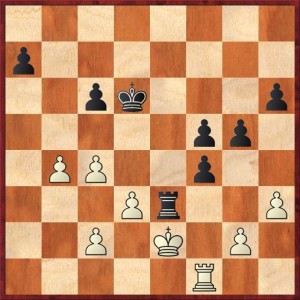
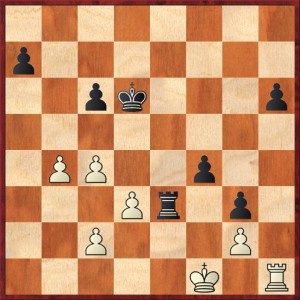
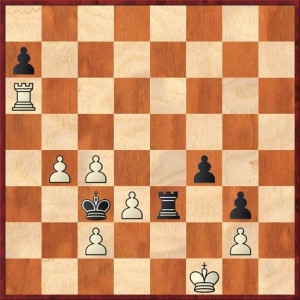
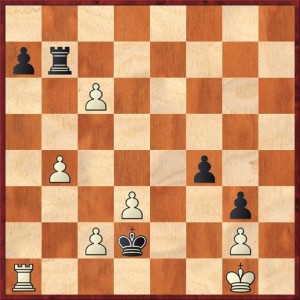
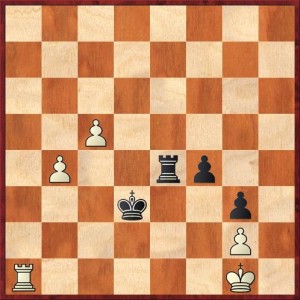
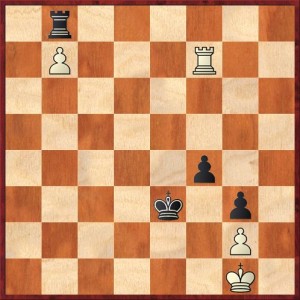



{ 5 comments… read them below or add one }
Hi Dana. Thank you for the comments on this wonderful (if painful) game. The endgame after g4?(?) deserves a few hours of analysis which, if carried out, might in itself be an eye opener. And I hope to do it some day (+1 to list – every game I play gets added on to that list). What is most shocking though is that I couldn’t see how I could even play such a move, and this realization hit me as soon as we made the time control. Throughout the opening and early middlegame, it seemed to me that I could ‘press’, but the position – as you noted – wasn’t one where black should be pressing at all. The truth was that before making a massive commitment as the g4 move, it necessitated a very long think. We were both struggling with the time, but white’s moves weren’t all that hard to find (although if I had been playing white, I would have messed up there too) if he didn’t do anything monumental.
This goes back to something I have been reading from several endgame books. “Do not hurry”. Usually, the context for that is to not blow a won game by doing something hasty. But here, the game went from being nearly ‘equal’ (but a very difficult =, maybe +/= for white) to nearly losing for black. We could analyze moves like Re6 (passive defense) for sometime to convince ourselves of how good white’s position became.
30… g4?? was the last move before the time control, and it’s better to make a waiting, stopgap move. But the psychology of the typical patzer (you need to play with initiative – what?) is to lunge, play seemingly feel good moves that ‘do’ something when it might just be better to wait for your opponent to do things. In that count, I guess master level players just win countless games by waiting. This was a very debilitating point that still hurts when I look back.
Aside from the above discursion, 30…g4 was faulty for the following technical reasons.
1. It opens up the file for the white rook, which hitherto was doing nothing (well, white would have played the rook to a1 in any case, but that’s another story).
2. As you point out, black’s pawn structure is none too good, to put it mildly.
After we made time control, it dawned on me that I was actually in very deep trouble. I think I had made several inferior moves leading up to g4 too – with my king, which was getting in the way of things. But anyway, going back to the game – we see that black three weaklings on h, c and a which are prime targets for a mobile rook. On the other hand, the black rook can’t really get at the enemy pawns. I could not bring myself to defend with the rook (say to e6), as white would then deploy along the fifth and then switch to a, or otherwise, Kf2 and then Ra1. And this was why I had no difficulty in deciding on Ke5 – I actually thought that it was winning for me too (after overlooking your resource).
In some rare, technically virtuous endgames written by good authors, they talk about pawn islands. This game could perhaps be taken as an illustration of that concept. After the opening of the h file, white had two pawn islands, while black has four. Actually, I was a little worried about my queenside pawns even before the unfortunate lunge, that of your rook going to a1. It then transpires that white was just better all along – in spite of being a little cramped. We often value dynamics over statics. In this case, the statics get their comeuppence which in my opinion is a very refreshing thing to see (okay, white’s has the dynamic advantage because of his rook, but then maybe we are just getting too hung up over this static-dynamic stuff).
The aggressive king walk gave me a rush of sorts – I am a big fan of king walks (such as Short-Timmman, Petrosian-Botvinnik, Petrosian-Unzicker, and Kramnik-Leko) so it was nice to try to copy my heroes. I didn’t calculate it properly though. That it ‘nearly’ works is pure luck.
After your c6(!) move, I was totally befuddled by the various options, none of which seemed good. I think that holding that endgame for black would have required a degree of virtuosity befitting the very best masters. I was just totally outplayed going into the ending and beyond.
In terms of engagement, drama and all (not counting our other game, which I thought carried it one logarithmic level higher) this game was worth the tournament entry fee. It had this very high level of tension from very early on. As I often preach (but seldom practice), it is a talent to make efficient, seemingly useless moves. Initiative chess teaches some very bad habits, not least of which is that one can be blinded by it and not recognize the moment when we should transition to a different phase.
I think I can say that g4 was an instructive mistake for all the reasons we have examined above. Nonetheless, I think these psychologically oriented mistakes repeat themselves, leading one to the pessimistic conclusion that there is no salvation for the average cheaper!
Oh by the way, at the risk of spamming – Rb6 was not easy to see. During the game, I thought that instead of 30…g4, 30… h5 might have been more to the point. Mike Splane mentioned today that the a pawn was going to drop. Inroads could then be made (maybe) with h5-h4 and then something like Rg3 and f4-f3 later on. But white might probably work on the queenside with the rook. The other point (which needs some foresight) is that the queen trades prior to this had to be judged accordingly – that it was favorable for white, and unfavorable for black. I don’t recall how we ended up trading. In fact, I hardly understood anything in the middle game at all, except being terribly cluttered with all the tactics and ‘lines’. But we see again that decisions that we take far back in the middlegame has telling effects later on.
The Re7 line harks back to the jailed king variation with the R on b8. All very simple now it appears 🙂 – thank you for the excellent analysis again.
Praveen, Thanks for some great and very insightful comments! It’s interesting to hear about the game from your perspective. As you probably know, I am a big fan of “initiative chess,” so it’s very instructive to me, too, to see a game where weaknesses were more important than initiative. This is a game Mike Splane probably would have drawn as Black, because he would have just sat and waited.
The time pressure phenomenon is also something I am very familiar with from my own games. In time pressure, I tend to play even *more* recklessly and even more for the initiative. You really have to make a conscious effort not to play risky moves in time pressure. If it makes you feel better, there is no question that I would have played 30. … g4?! if my flag was hanging. So this was a lesson for me as well as for you.
You’re right that some of the earlier parts of the game need analysis too. At some point it seemed as if Black should have an advantage, but somehow that slipped away. It’s possible, again, that you pressed harder than you should have by playing …f5 prematurely. That led to the opening of the long diagonal, which led to my Qxb7, which really turned out to be hugely important because that’s what gave you the weak pawn structure.
Also, as you noted, you allowed a queen trade when you could have avoided it. This was a mistake for you because (1) it ended the middlegame phase, when my king was in much more danger than yours, and (2) it entered an endgame that turned out to be not very good for you! Point (2) was hard to appreciate at the time, but point (1) was obvious.
I hope it won’t be construed as bragging if I say that one thing I was really proud of was my handling of the endgame. We could have gone into a bishop endgame, a rook endgame, or a king-and-pawn endgame, and I think that the rook endgame was exactly the right one. Also I moved my king to the right side of the board when I had the chance, and finally I hit on the right plan of attack after 30. … g4.
For other readers besides Praveen, sorry for talking about moves 1-29 when I haven’t shown them to you!
Yes, I would rate this as among the best played and enjoyable endgames (in my limited experience, and notwithstanding the result, which of course doesn’t matter). Should sit down with the board now that the healing has happened and try to obsess over it.
One final point here – in response to Dana’s comment, which relates to trading and is not often emphasized when we do move on move analysis. Making judgments on trading correctly is a skill might be one of the hardest, and most important aspects of the game. As this game shows, all the trades leading up to the *nearly winning* endgame for white were conducted by me in generally oblivious fashion. Actually, in the middle game I thought I had a cute deflecting manoeuvre to trap the white queen by allowing Qxb7 and then playing c6, thus wrecking my pawns. I don’t know if Dana saw that this static feature was going to play a vital role later on in the endgame (which of course, depended on trading down), but he might have known it intuitively, as the game’s further course demonstrates. These sort of subtle assessments regarding long term statics vs short term activity tend to decide games, and in my opinion can only come from ‘feel’. In the game, white’s assessment turned out to be correct, in spite of all the turbulence ensuing as a result of the pawn grab. I got so befuddled from the murkiness that I just trade down. And of all the choices, we went into a piece configuration that was most favorable for white. Sometimes, I feel that you have to have a split personality while evaluating positions. The first would be one that calculates (which most people do, with variable levels of skill), and the other that gauges the very long term ‘quality’ of the position. Kasparov mentions this in connection with Petrosian, which I quote verbatim here, at the risk of another massive digression. The game in question was Petrosian vs Suetin 1954 and the position is after black’s 15 th move in:
http://www.chessgames.com/perl/chessgame?gid=1106270
“The knight on e5 is a fine piece, and the one on c5 also stands well, whereas for the moment Black’s weaknesses (the f5-pawn and the e6 and g6 squares) are not felt. And again, we encounter an example, typical of our previous theme: the correlation between long-term factors and the concrete dynamics of the position. It is useful and interesting to observe how skilfully and accurately the young Petrosian (who was then still only 25) begins to change the evaluation in his favor.”
{ 1 trackback }